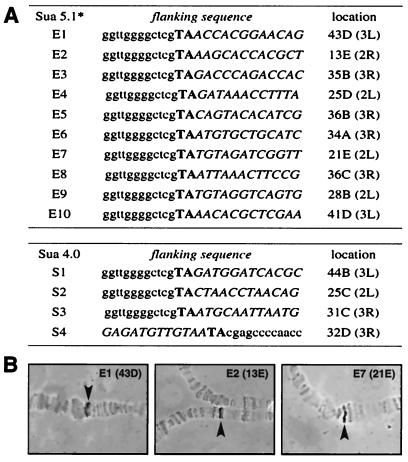GENETICS. In the article “Toward Anopheles transformation: Minos element activity in anopheline cells and embryos” by Flaminia Catteruccia, Tony Nolan, Claudia Blass, Hans-Michael Müller, Andrea Crisanti, Fotis C. Kafatos, and Thanasis G. Loukeris, which appeared in number 5, February 29, 2000, of Proc. Natl. Acad. Sci. USA (97, 2157–2162), the authors note that three mistakes were introduced inadvertently in assembling Fig. 4. The revised Fig. 4 printed below includes the correct photograph of E7 insertion at 21E, as well as the correct chromosomal locations of E4 at 25D (2L) and E5 at 36B (3R).
Figure 4.
(A) Sequences of the Minos insertion sites in the genome of Sua 5.1* and Sua 4.0 cells. Chromosomal flanking sequences are represented with capital letters in italics. Small lettering represents the sequences of the Minos end. The expected TA dinucleotide of the insertion site is shown in bold. The chromosomal divisions and subdivisions from which the flanking sequences were derived are indicated with the chromosomal arm listed in parenthesis. (B) Typical results of determining the location of origin of the rescued genomic fragments by in situ localization to polytene chromosomes of the Suakoko mosquito strain.



